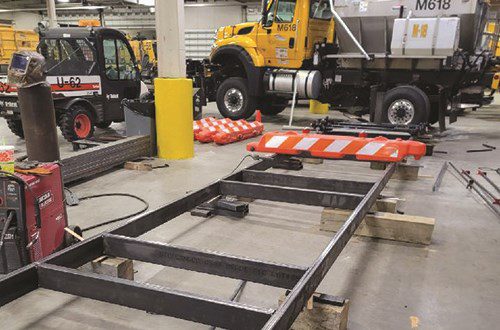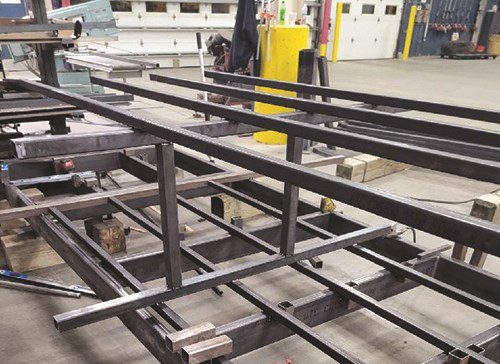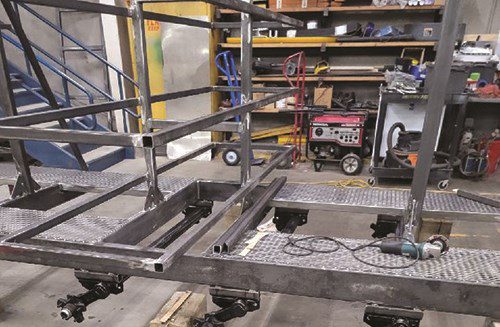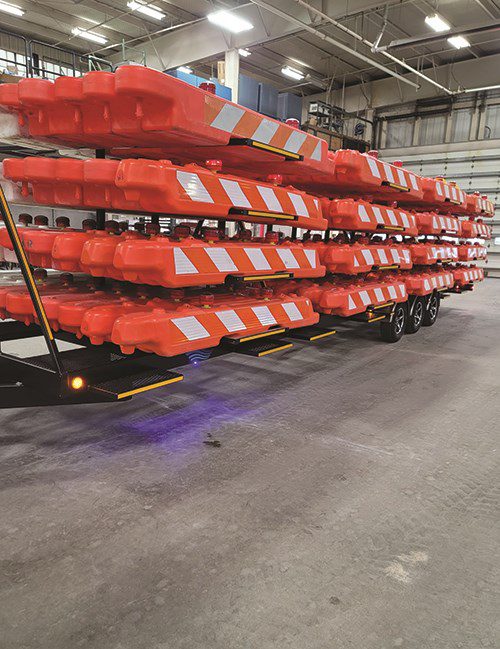Picture this: A small portion of the airfield at Gerald R. Ford International Airport (GRR) in Grand Rapids, MI, needs to be repaired. For safety purposes, low-profile barricades must be placed around the work zone. The area in question is about a quarter-mile from the shed where the barricades are stored, so crews would presumably need to haul the bulky barriers to the construction site in the back of a pickup truck, which can only carry five barricades at a time. The job requires 60 barricades, so that means 12 round trips and several hours of time.
Picture this: A small portion of the airfield at Gerald R. Ford International Airport (GRR) in Grand Rapids, MI, needs to be repaired. For safety purposes, low-profile barricades must be placed around the work zone.
The area in question is about a quarter-mile from the shed where the barricades are stored, so crews would presumably need to haul the bulky barriers to the construction site in the back of a pickup truck, which can only carry five barricades at a time. The job requires 60 barricades, so that means 12 round trips and several hours of time. Naturally, when the repair is done, the barricades need to be returned to the shed, meaning 12 more trips and who knows how many labor hours—all for just one minor airfield repair.
Setting up and taking down barricades is a standard routine for airports, and most agree on one thing: It’s a drain on valuable resources.
Last year, the maintenance team at GRR changed that picture by designing and building a custom trailer they tow with a standard pickup truck. The 40-foot trailer can carry up to 160 barricades at a time, making the process significantly faster, safer and more efficient. It is also used to store the safety barriers when not in active use.
Maintenance personnel managed to design and construct the DIY solution between their other regular duties and spent only $10,000 on materials.

Their initiative and accomplishment have not gone unnoticed by the airport’s top leadership.
 “The barricade trailer project is an accurate reflection of our commitment to improving the operations of airport maintenance,” says Tory Richardson, president and chief executive officer of the Gerald R. Ford International Airport Authority. “We are grateful to have skilled team members who go above and beyond to serve the community in innovative ways.”
“The barricade trailer project is an accurate reflection of our commitment to improving the operations of airport maintenance,” says Tory Richardson, president and chief executive officer of the Gerald R. Ford International Airport Authority. “We are grateful to have skilled team members who go above and beyond to serve the community in innovative ways.”
Added Protection
For years, GRR’s 200-some barricades were stored in a maintenance shed at the end of a runway. “We’d keep them on the ground, but then things would fall on them, or they’d get knocked around,” explains Lonny Shirey, the equipment operator and maintenance team member who spearheaded the fix. “And when you loaded them into the truck each time you needed them, they often got damaged. The lights alone at the top of each barricade can run upwards of $25 apiece, so you’re talking about damage that can get quite costly.”
 Loading and unloading the barriers was also a time drain for staff. “You had to go back to the shop and to the airfield over and over again,” says Airfield Maintenance Superintendent Rory Wolters.
Loading and unloading the barriers was also a time drain for staff. “You had to go back to the shop and to the airfield over and over again,” says Airfield Maintenance Superintendent Rory Wolters.
A few years ago, Shirey and the team constructed a makeshift trailer from the bed of an old pontoon boat and pulled it behind a pickup truck. That could accommodate 32 barricades and worked for a while. “At the time, we didn’t have to supply contractors with barricades since they normally supplied their own during the bidding process,” Shirey recalls. “As time progressed, we were supplying barricades for bigger jobs and the demand required a bigger trailer to safely transport them.”
That’s when the team went back to the drawing board and created a larger, purpose-built trailer. Last fall, the airport approved Shirey’s proposal to construct an entirely new trailer from the ground up to store and haul 160 barricades. “Lonny’s a very talented individual and does all our fabrication work,” Wolters says. “When he came up with this idea, we decided to just let him run with it.”
 The initial design was a 46-foot trailer that could accommodate all of the airport’s barricades, but it proved to be hard to maneuver. “It was bad for turns,” says Shirey. “It was just so long and so massive that I figured it wouldn’t make a wide turn safely. So I knocked it down to 40 feet.”
The initial design was a 46-foot trailer that could accommodate all of the airport’s barricades, but it proved to be hard to maneuver. “It was bad for turns,” says Shirey. “It was just so long and so massive that I figured it wouldn’t make a wide turn safely. So I knocked it down to 40 feet.”
Design work was completed in September, and the wheels, rims, axles, lighting and steel were ordered shortly there after. Construction began in December (after the fall airfield construction season), and took about eight weeks to complete. The team worked on the trailer between its other winter duties.
Design Features
|
Project: Custom Trailer for Barricades Location: Gerald R. Ford Int’l Airport—Grand Rapids, MI Length: 40 ft. Capacity: 160 low-profile construction barricades Design & Construction: Airport maintenance team Cost of Materials: $10,000 Key Benefit: Saves time & labor needed to dispatch barricades to construction sites; trailer also stores barricades when they’re not in use |
Now, barricades can be stacked on top of each other, and steps around the trailer allow easy access for loading and unloading. “I built it short enough to the ground so one person can reach the top rack,” says Shirey, noting that loading and loading used to be a two-person job. “There are steps all the way around the whole trailer to access the top rack. And each rack has floodlights on the top, so when we load and unload at night, we can see better. A lot of the time, we are doing that work at night.”
The GRR team got added assistance from Dillion Edema, a seasonal worker who became Shirey’s “right-hand man” for the trailer project.
“Dillion was a godsend; he helped so much,” Shirey recalls. “I would give him dimensions of steel to cut, and he would do it for eight hours a day, then pile it up and label it. Whatever I needed, he would cut.”
After all the required parts were assembled, the team got creative. Another seasonal worker Mark Lytel (who is also a pilot) suggested adding an airplane tail fin to the rear of the trailer for design flair. The worker sketched out the tail and used a 3D printer to produce a mockup. The team then used scrap metal from the project to create the tail fin. “It looks like a real airplane tail!” says Shirey.

The finishing touch was installing lights on the rear of the trailer, and the team again chose to make an aviation-related design statement. The right light is green and the left is red, just like a Bombardier RJ.
Ready to Go
While the new trailer can hold 160 barricades, GRR’s remaining 40 or so barricades are kept on the old pontoon-boat trailer. Storing all of the barricades on trailers means they are always ready to go for a construction job—no loading required. “It’s definitely a timesaver,” says Airfield Maintenance Supervisor Richard Feigel. “With this setup, we can now do a closure in one trip. And it expedites the cleanup process as well.”
Other airports interested in building their own barricade trailers are welcome to contact GRR about its unit. Feigel says he is happy to share its specifications and images of the layout and construction. “We’d love to help them coordinate whatever is needed and help with their plans,” he says. “Ours is beautiful. We had a spectacular crew working on it.”




 facts&figures
facts&figures

